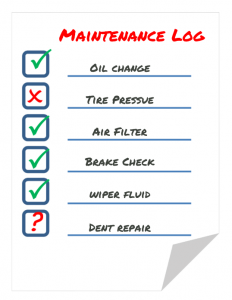
An unfortunate aspect of keeping things at their best is regular maintenance. It’s why we schedule manicures and clean the bathroom even though we swear we just scrubbed it days ago.
After completing a maintenance task, it’s so simple to check it off the to-do list and forget about it entirely. While the feeling may be freeing, it can be of huge benefit to keep track of when and how often upkeep was performed, especially when it comes to your vehicle.
A car maintenance log is an easy tool for ensuring your vehicle is receiving the routine services it requires, diagnosing issues faster and getting more out of your resale. Not only do you benefit by keeping your vehicle in tip-top condition, a maintenance log can be of enormous assistance to mechanics when performing service and repairs on your ride. With a variety of apps designed to keep track of your car’s care, maintaining a vehicle log has never been easier.
Whether your a tech tracker or prefer to do it the old fashioned way, follow these tips to remember every detail of what’s done to your car.
1. Keep it traditional with a small notebook that fits nicely in your glovebox, or do it digitally with apps like
Vehicle Logbook. However you choose to track it, the key is keeping it up-to-date.
- Choose a notebook with at least 100 pages to ensure it lasts through the life of your vehicle.
- Write down the current condition, VIN number, insurance information, tire wear, and vehicle mileage on the first page of the log.
- Backlog any recent repairs or maintenance, as well as any noticeable changes that occurred as soon as you purchase the logbook.
2. Every time you fill your tank, make note of the date, vehicle mileage, and gallons added to track your vehicle’s gas mileage over time, which can be a good indicator of how it’s performing.
3. As you get an oil change, note the date, where it was performed, as well as the type of oil used.
4. Keep note of what kind of tires you’re using and manage reminders to check air pressure regularly.
5. Create reminders to change air filters and inspect breaks routinely.
6. If your car is in an accident, be sure to include all details about the damage within the log. Note any previous incidents involving your vehicle as well.
7. If you notice your car is not functioning properly or is acting up, write down the issues and what you were doing prior to assist the mechanic shop in diagnosing the problem quickly.
When it comes to a vehicle maintenance log, a little effort can go a long way in giving you peace of mind about your vehicle’s condition and performance. When you do decide to sell/trade your ride, the buyer and your wallet are sure to thank you!






No Comments